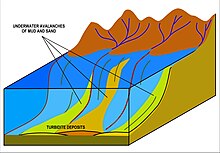
A turbidite is the geologic deposit of a turbidity current, which is a type of amalgamation of fluidal and sediment gravity flow responsible for distributing vast amounts of clastic sediment into the deep ocean.

A turbidite is the geologic deposit of a turbidity current, which is a type of amalgamation of fluidal and sediment gravity flow responsible for distributing vast amounts of clastic sediment into the deep ocean.
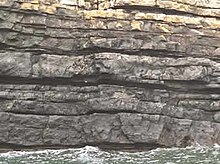

Turbidites were first properly described by Arnold H. Bouma (1962), [1] who studied deepwater sediments and recognized particular "fining-up intervals" within deep water, fine-grained shales, which were anomalous because they started at pebble conglomerates and terminated in shales. This was anomalous because within the deep ocean it had historically been assumed that there was no mechanism by which tractional flow could carry and deposit coarse-grained sediments into the abyssal depths.
Bouma cycles begin with an erosional contact of a coarse lower bed of pebble to granule conglomerate in a sandy matrix, and grade up through coarse then medium plane parallel sandstone; through cross-bedded sandstone; rippled cross-bedded sand/silty sand, and finally laminar siltstone and shale. This vertical succession of sedimentary structures, bedding, and changing lithology is representative of strong to waning flow regime currents and their corresponding sedimentation.
It is unusual to see all of a complete Bouma cycle, as successive turbidity currents may erode the unconsolidated upper sequences. Alternatively, the entire sequence may not be present depending on whether the exposed section was at the edge of the turbidity current lobe (where it may be present as a thin deposit), or upslope from the deposition centre and manifested as a scour channel filled with fine sands grading up into a pelagic ooze.
It is now recognized that the vertical progression of sedimentary structures described by Bouma applies to turbidites deposited by low-density turbidity currents. As the sand concentration of a flow increases, grain-to-grain collisions within the turbid suspension create dispersive pressures that become important in hindering further settling of grains. As a consequence, a slightly different set of sedimentary structures develops in turbidites deposited by high-density turbidity currents. This different set of structures is known as the Lowe sequence, which is a descriptive classification that complements, but does not replace, the Bouma sequence. [2]
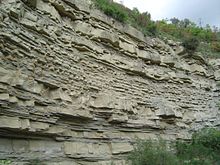
Turbidites are sediments which are transported and deposited by density flow, not by tractional or frictional flow.
The distinction is that, in a normal river or stream bed, particles of rock are carried along by frictional drag of water on the particle (known as tractional flow). The water must be travelling at a certain velocity in order to suspend the particle in the water and push it along. The greater the size or density of the particle relative to the fluid in which it is travelling, the higher the water velocity required to suspend it and transport it.
Density-based flow, however, occurs when liquefaction of sediment during transport causes a change to the density of the fluid. This is usually achieved by highly turbulent liquids which have a suspended load of fine grained particles forming a slurry. In this case, larger fragments of rock can be transported at water velocities too low to otherwise do so because of the lower density contrast (that is, the water plus sediment has a higher density than the water and is therefore closer to the density of the rock).
This condition occurs in many environments aside from simply the deep ocean, where turbidites are particularly well represented. Lahars on the side of volcanoes, mudslides and pyroclastic flows all create density-based flow situations and, especially in the latter, can create sequences which are strikingly similar to turbidites.
Turbidites in sediments can occur in carbonate as well as siliciclastic sequences.
Classic, low-density turbidites are characterized by graded bedding, current ripple marks, climbing ripple laminations, alternating sequences with pelagic sediments, distinct fauna changes between the turbidite and native pelagic sediments, sole markings, thick sediment sequences, regular bedding, and an absence of shallow-water features. [3] A different vertical progression of sedimentary structures characterize high-density turbidites. [2]
Massive accumulations of turbidites and other deep-water deposits may result in the formation of submarine fans. Sedimentary models of such fan systems typically are subdivided into upper, mid, and lower fan sequences each with distinct sand-body geometries, sediment distributions, and lithologic characteristics. [4] [5] [6]
Turbidite deposits typically occur in foreland basins.
Submarine fan models are often based on source-to-sink [S2S] concepts linking sediment source areas, and sediment routing systems to the eventual depositional environments of turbidite deposits. They are aimed at providing insights into the relationships between different geologic processes and turbidite fan systems. Geologic processes influencing turbidite systems can either be of allogenic or autogenic origin and submarine fan models are designed to capture the impact of these processes on reservoir presence, reservoir distribution, morphology, and architecture of turbidite deposits. [7] [8] Some significant allogenic forcing includes the effect of sea level fluctuations, regional tectonic events, sediment supply type, sediment supply rate, and sediment concentration. [7] Autogenic controls can include seafloor topography, confinements, and slope gradients. [9] There are about 26 submarine fan models. [10] Some common fan models include the classical single-source suprafan model, models depicting fans with attached lobes, detached lobes fan model, and submarine fan models relating to the response of turbidite systems to varying grain sizes and different feeder systems. [11] [12] [13] [7] The integration of subsurface datasets such as 3D/4D seismic reflection, well logs, and core data as well as modern seafloor bathymetry studies, numerical forward stratigraphic modeling, and flume tank experiments are enabling improvements and more realistic development of submarine fan models across different basins. [14] [15]
Turbidites provide a mechanism for assigning a tectonic and depositional setting to ancient sedimentary sequences as they usually represent deep-water rocks formed offshore of a convergent margin, and generally require at least a sloping shelf and some form of tectonism to trigger density-based avalanches. Density currents may be triggered in areas of high sediment supply by gravitational failure alone. Turbidites can represent a high resolution record of seismicity, and terrestrial storm/flood events depending on the connectivity of canyon/channel systems to terrestrial sediment sources. [16]
Turbidites from lakes and fjords are also important as they can provide chronologic evidence of the frequency of landslides and the earthquakes that presumably formed them, by dating using radiocarbon or varves above and below the turbidite. [17] [18]
Turbidite sequences are classic hosts for lode gold deposits, the prime example being Bendigo and Ballarat in Victoria, Australia, where more than 2,600 tons of gold have been extracted from saddle-reef deposits hosted in shale sequences from a thick succession of Cambrian-Ordovician turbidites. Proterozoic gold deposits are also known from turbidite basin deposits.
Lithified accumulations of turbidite deposits may, in time, become hydrocarbon reservoirs and the petroleum industry makes strenuous efforts to predict the location, overall shape, and internal characteristics of these sediment bodies in order to efficiently develop fields as well as explore for new reserves.

Sedimentary rocks are types of rock that are formed by the accumulation or deposition of mineral or organic particles at Earth's surface, followed by cementation. Sedimentation is the collective name for processes that cause these particles to settle in place. The particles that form a sedimentary rock are called sediment, and may be composed of geological detritus (minerals) or biological detritus. The geological detritus originated from weathering and erosion of existing rocks, or from the solidification of molten lava blobs erupted by volcanoes. The geological detritus is transported to the place of deposition by water, wind, ice or mass movement, which are called agents of denudation. Biological detritus was formed by bodies and parts of dead aquatic organisms, as well as their fecal mass, suspended in water and slowly piling up on the floor of water bodies. Sedimentation may also occur as dissolved minerals precipitate from water solution.
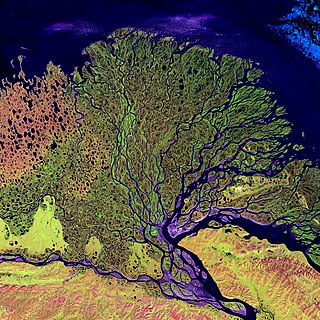
A river delta is a landform shaped like a triangle, created by the deposition of sediment that is carried by a river and enters slower-moving or stagnant water. This occurs when a river enters an ocean, sea, estuary, lake, reservoir, or another river that cannot carry away the supplied sediment. It is so named because its triangle shape resembles the Greek letter Delta. The size and shape of a delta are controlled by the balance between watershed processes that supply sediment, and receiving basin processes that redistribute, sequester, and export that sediment. The size, geometry, and location of the receiving basin also plays an important role in delta evolution.

An alluvial fan is an accumulation of sediments that fans outwards from a concentrated source of sediments, such as a narrow canyon emerging from an escarpment. They are characteristic of mountainous terrain in arid to semiarid climates, but are also found in more humid environments subject to intense rainfall and in areas of modern glaciation. They range in area from less than 1 square kilometer (0.4 sq mi) to almost 20,000 square kilometers (7,700 sq mi).

Conglomerate is a clastic sedimentary rock that is composed of a substantial fraction of rounded to subangular gravel-size clasts. A conglomerate typically contains a matrix of finer-grained sediments, such as sand, silt, or clay, which fills the interstices between the clasts. The clasts and matrix are typically cemented by calcium carbonate, iron oxide, silica, or hardened clay.
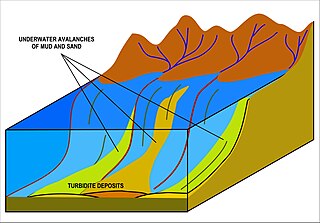
A turbidity current is most typically an underwater current of usually rapidly moving, sediment-laden water moving down a slope; although current research (2018) indicates that water-saturated sediment may be the primary actor in the process. Turbidity currents can also occur in other fluids besides water.
Emiliano Mutti is a geologist who has made significant contributions to petroleum geosciences, especially to sedimentary dynamics of turbidites and their reservoir characterization.

The Bouma sequence describes a classic set of sedimentary structures in turbidite beds deposited by turbidity currents at the bottoms of lakes, oceans and rivers.

Abyssal fans, also known as deep-sea fans, underwater deltas, and submarine fans, are underwater geological structures associated with large-scale sediment deposition and formed by turbidity currents. They can be thought of as an underwater version of alluvial fans and can vary dramatically in size, with widths from several kilometres to several thousands of kilometres. The largest is the Bengal Fan, followed by the Indus Fan, but major fans are also found at the outlet of the Amazon, Congo, Mississippi and elsewhere.

The Ecca Group is the second of the main subdivisions of the Karoo Supergroup of geological strata in southern Africa. It mainly follows conformably after the Dwyka Group in some sections, but in some localities overlying unconformably over much older basement rocks. It underlies the Beaufort Group in all known outcrops and exposures. Based on stratigraphic position, lithostratigraphic correlation, palynological analyses, and other means of geological dating, the Ecca Group ranges between Early to earliest Middle Permian in age.
Gerard Viner Middleton FRSC, often known as Gerry Middleton, was a Canadian geologist and university teacher.
A subaqueous fan is a fan-shaped deposit formed beneath water, and are commonly related to glaciers and crater lakes.

Marine sediment, or ocean sediment, or seafloor sediment, are deposits of insoluble particles that have accumulated on the seafloor. These particles have their origins in soil and rocks and have been transported from the land to the sea, mainly by rivers but also by dust carried by wind and by the flow of glaciers into the sea. Additional deposits come from marine organisms and chemical precipitation in seawater, as well as from underwater volcanoes and meteorite debris.
Abyssal channels are channels in Earth's sea floor. They are formed by fast-flowing floods of turbid water caused by avalanches near the channel's head, with the sediment carried by the water causing a build-up of the surrounding abyssal plains. Submarine channels and the turbidite systems which form them are responsible for the accumulation of most sandstone deposits found on continental slopes and have proven to be one of the most common types of hydrocarbon reservoirs found in these regions.

A contourite is a sedimentary deposit commonly formed on continental rise to lower slope settings, although they may occur anywhere that is below storm wave base. Countourites are produced by thermohaline-induced deepwater bottom currents and may be influenced by wind or tidal forces. The geomorphology of contourite deposits is mainly influenced by the deepwater bottom-current velocity, sediment supply, and seafloor topography.
A dish structure is a type of sedimentary structure formed by liquefaction and fluidization of water-charged soft sediment either during or immediately following deposition.

A sediment gravity flow is one of several types of sediment transport mechanisms, of which most geologists recognize four principal processes. These flows are differentiated by their dominant sediment support mechanisms, which can be difficult to distinguish as flows can be in transition from one type to the next as they evolve downslope.

The Lowe sequence describes a set of sedimentary structures in turbidite sandstone beds that are deposited by high-density turbidity currents. It is intended to complement, not replace, the better known Bouma sequence, which applies primarily to turbidites deposited by low-density turbidity currents.
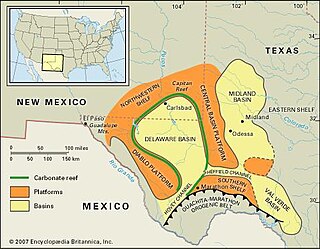
The Val Verde Basin is a marginal foreland basin located in West Texas, just southeast of the Midland Basin. The Val Verde is a sub-basin of the larger Permian Basin and is roughly 24–40 km wide by 240 km long. It is an unconventional system and its sediments were deposited during a long period of flooding during the Middle to Late Cretaceous. This flooding event is referred to as the Western Interior Seaway, and many basins in the Western United States can attribute their oil and gas producing basins to carbonate deposition during this time period.

Cindy A. Yeilding is an American geologist from Houston, Texas. Yeilding is Senior Vice President of British Petroleum, America. She was formerly Vice President of exploration technology and assurance, and has held various other positions at BP in oil and gas, exploration of the Gulf of Mexico and geoscience.

The Indus Fan is one of the most significant depositional feature of the offshore Indus basin. It is the second largest fan system in the world after the Bengal Fan between India, Bangladesh and the Andaman Islands. The Indus fan was deposited in an unconfined setting on the continental slope, rise and basin floor, covering much of the Arabian Sea. The entire fan extends over an area of 110,000 square kilometers with greater than 9 km of sediment accumulating near the toe-of-slope.